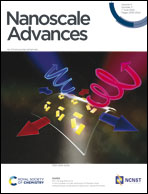Rare earth metal (Sm)-doped NiMnO3 nanostructures for highly competent alkaline oxygen evolution reaction
Abstract
In the present work, samarium-doped nickel manganese oxide was produced by employing a straightforward co-precipitation method. A peak with a 2θ of 36° corresponded to the (110) plane confirming the formation of the rhombohedral crystal structure of NiMnO3. The existence of Mn–O and Ni–O stretching vibration modes was confirmed by Raman spectroscopy. FTIR spectra confirmed the existence of the metal–oxygen bond of NiMnO3. The synthesized ternary Ni-based material was found to be spherical nanoparticles with an average diameter of 0.81 μm. The electrochemical oxygen evolution reaction (OER) performance was explored on 0.02 M samarium (Sm)-doped NiMnO3 demonstrating outstanding OER action with low 321 mV, a low Tafel slope value (109 mV dec−1), and low charge-transfer resistance (0.19 Ω). Moreover, the BET results suggest that the 0.02 M Sm-doped NiMnO3 exhibited elevated surface area (78.78 m2 g−1) with a mesoporous character. Therefore, NiMnO3 doped with high concentrations of a rare earth metal, Sm, is proposed as a suitable material for next-generation water splitting applications.

- This article is part of the themed collection: Celebrating nanoscience in India


 Please wait while we load your content...
Please wait while we load your content...